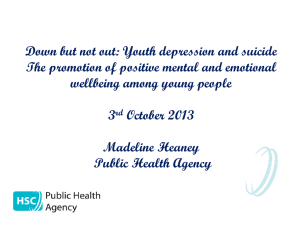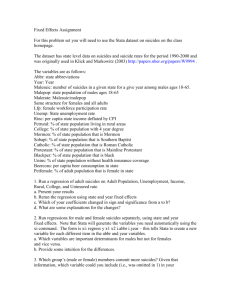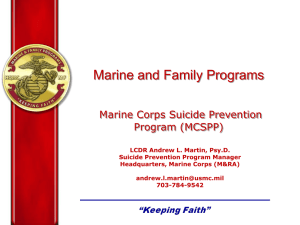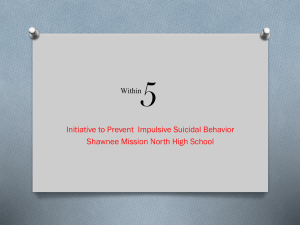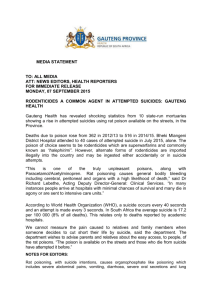Medically enabled suicides J. Varelius and M. Cholbi (eds.), New
advertisement
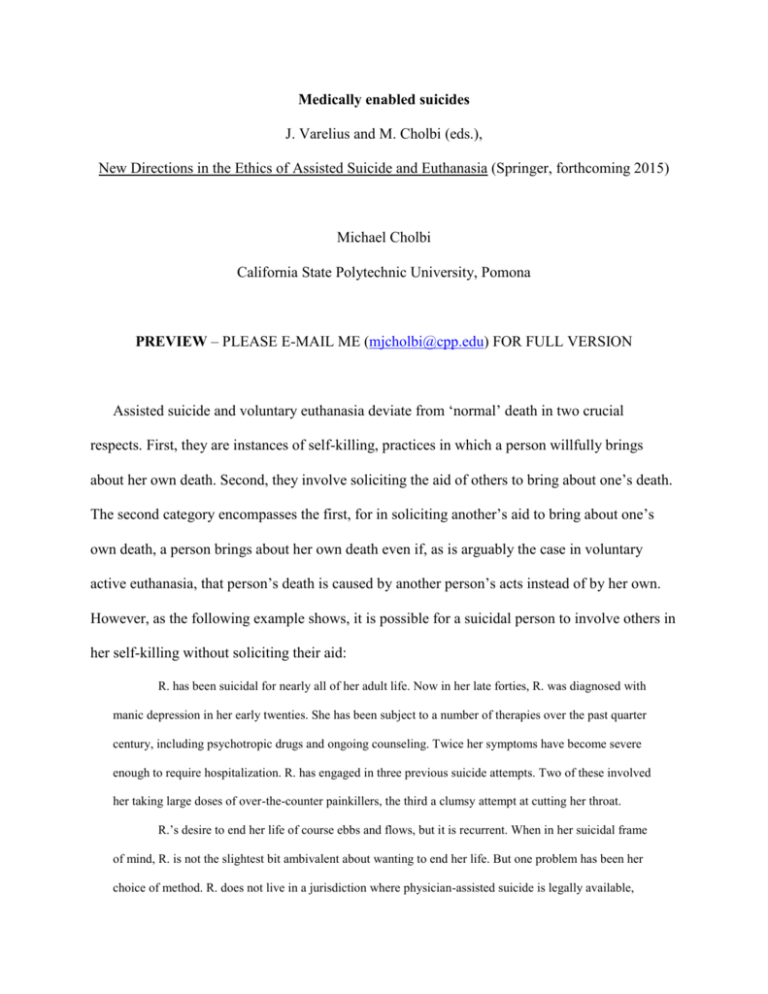
Medically enabled suicides J. Varelius and M. Cholbi (eds.), New Directions in the Ethics of Assisted Suicide and Euthanasia (Springer, forthcoming 2015) Michael Cholbi California State Polytechnic University, Pomona PREVIEW – PLEASE E-MAIL ME (mjcholbi@cpp.edu) FOR FULL VERSION Assisted suicide and voluntary euthanasia deviate from ‘normal’ death in two crucial respects. First, they are instances of self-killing, practices in which a person willfully brings about her own death. Second, they involve soliciting the aid of others to bring about one’s death. The second category encompasses the first, for in soliciting another’s aid to bring about one’s own death, a person brings about her own death even if, as is arguably the case in voluntary active euthanasia, that person’s death is caused by another person’s acts instead of by her own. However, as the following example shows, it is possible for a suicidal person to involve others in her self-killing without soliciting their aid: R. has been suicidal for nearly all of her adult life. Now in her late forties, R. was diagnosed with manic depression in her early twenties. She has been subject to a number of therapies over the past quarter century, including psychotropic drugs and ongoing counseling. Twice her symptoms have become severe enough to require hospitalization. R. has engaged in three previous suicide attempts. Two of these involved her taking large doses of over-the-counter painkillers, the third a clumsy attempt at cutting her throat. R.’s desire to end her life of course ebbs and flows, but it is recurrent. When in her suicidal frame of mind, R. is not the slightest bit ambivalent about wanting to end her life. But one problem has been her choice of method. R. does not live in a jurisdiction where physician-assisted suicide is legally available, and even if she did, she would probably not qualify because her medical condition is neither terminal nor ‘futile’. She finds her past suicide attempts a bit embarrassing: Only a coward uses methods known to be so ineffective. R. knows that that guns are likely to be the most effective method, but she does not know the first thing about guns or how to get ahold of one — and even if she did, her history of hospitalization for mental illness would probably serve as a legal obstacle to obtaining a gun permit. R. is also reluctant to use violent methods or methods that would inflict physical trauma on her body because she does not want to be found in a bloody or brutalized state by her family. R. is thus in a quandary: Many of the most effective suicide methods are either unavailable or unattractive, but readily available methods are unreliable at best. Furthermore, she does not want to upset anyone through her suicide. She desires, above all else, a ‘normal’ death. R.’s sister invites her to housesit while the sister and her family enjoy a vacation. R. recalls that her sister recently had the powerful painkiller oxycodone prescribed to her after major back surgery. Again feeling like life is futile, R. rummages through the medicine chest and finds the bottle of oxycodone and swallows ten times the dose suggested on the bottle. R. then calls a taxicab and directs the driver to deliver her to the nearest emergency room. Within minutes after her arrival, R. collapses, unconscious. Hospital staff witness her collapse, find that her breathing has stopped, and ready her for emergency interventions. R. is fitted with an artificial ventilator. While her condition remains critical and her prognosis uncertain, R. can be kept alive indefinitely with the ventilator’s assistance. R.’s sister, listed on R.’s admission form as her medical contact, arrives at the hospital. One hour later thereafter, medical personnel find in R.’s purse an advance directive she completed two years prior. R.’s advance directive states that she does not wish to be revived or resuscitated if her breathing or cardiovascular activity stops, nor does she wish to receive artificial lifesaving measures. The attending physicians honor the wishes stated in her advance directive and remove R.’s ventilator. R. dies within five hours of consuming the overdose of pain medication. Assuming that R. completed the advance directive, with its ‘do not resuscitate’ clause, in anticipation of taking the drug overdose, then R. seemed to have knowingly and willfully implemented a plan that culminated in a death she endorsed. She seems then to have ended her life via suicide. But the example of R. is an atypical instance of suicide, a case of what I will call medically enabled suicide. Medically enabled suicides have four distinctive features: 1. They are instigated by actions of a suicidal individual, actions she intends to result in a physiological condition that, absent lifesaving medical interventions, would be otherwise fatal to that individual. In R.’s case, the painkiller overdose was aimed at putting her in a physiological state that is fatal. However, this state can nearly always be treated so as to prevent the patients’ death. 2. These suicides are ‘completed’ due to medical personnel acting in accordance with recognized legal or ethical protocols requiring the withholding or withdrawal of care from patients (e.g., following an approved advance directive). R. dies in part because medical personnel honor an advance directive proscribing her receiving lifesaving care. Medically enabled suicide could also occur when competent patients refuse lifesaving care ‘at the bedside’. 3. The suicidal individual acts purposefully to ensure that medical personnel will act on these protocols. R. filled our her advance directive recognizing that its provisions, if honored, would make it the case that her drug overdose would lead to her death. 4. These suicides do not involve medical personnel providing aid in dying in the standard sense, either through (a) active voluntary euthanasia, or (b) assistance by means of prescriptions, etc. Medically enabled suicides involve the participation of medical personnel, but not their “assistance,” as that is standardly understood. Medical personnel, acting on protocols requiring the withholding or withdrawal of care, participate in patients’ suicidal plans without consenting to participating in those plans insofar as those plans aim to end the patient’s life. The patient’s underlying physiological condition ends up killing her, rather than (say) the subsequent administration of a lethal medication. The frequency of medically enabled suicides cannot be estimated with any accuracy. In the United States, nearly half a million people are treated in emergency rooms for self-inflicted injuries or harm each year. (US Centers for Disease Control 2012). Recent surveys indicate that about one-third of adults have a living will or other provision for their end-of-life care. About half of all Americans indicate that there are some circumstances in which they would refuse or cease treatments even if this would result in their deaths. (Pew Research 2013) Of course, no reasonable inferences can be made from this data about the prevalence of medically enabled suicides. But the number of self-inflicted injuries, combined with the fact that many adults have concluded that they would sometimes prefer not to receive life sustaining treatments, suggests that medically enabled suicides, while rare, do occur. In a survey of English clinicians treating self-poisoning (reported in Kapur et al 2010), an advance directive was mentioned in 2.5 percent of cases. The case of Kerrie Wooltorton is a real life example where an advance directive came into play in the treatment of suicidal injuries. (Dresser 2010, Szawarski 2013) Regardless of how common medically enabled suicides are, they raise compelling questions at the interface of medicine and individual choice. After first clarifying the concept of medically enabled suicide and exploring some of the reasons why it might be attractive to suicidal individuals, I then investigate two apparent dilemmas that medically enabled suicides raise for medical care providers. The first alleges that medical care providers may not contribute to harming their patients, and so they may not contribute to their patients’ suicides. The second alleges that if care providers, as a matter of personal conscience, believe that suicide is wrong, then they may not be compelled to contribute to their patient’s acting wrongly by assenting to the wishes of a patient pursuing medically enabled suicide. Both dilemmas arise from the fact that while medical personnel are bound by widely accepted precepts of medical ethics to honor the competent wishes of their patients, medically enabled suicides entangle them in their patients’ suicidal plans in ways that result in their contributing to those suicides. I conclude that neither dilemma should be resolved in the direction of medical personnel having the right to refrain from involvement in medically enabled suicides. Thus, while we may find medically enabled suicide distasteful or exploitative, a strong case cannot be made that medical personnel refusing to involve themselves in such suicides is ethically permissible.


